NEWS
Rare Wild Tiger Caught On Camera in Bhutan
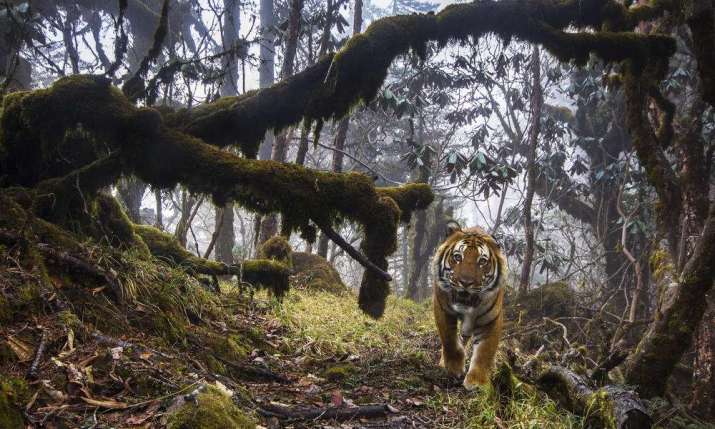 Endangered tiger in Bhutan. Photo by Emmanuel Rondeau. From worldwildlife.org
Endangered tiger in Bhutan. Photo by Emmanuel Rondeau. From worldwildlife.orgPerhaps best known for prioritizing Gross National Happiness over the profit-driven acquisitiveness of unrestrained economic growth, the Buddhist kingdom of Bhutan, nestled high in the rarified air of the eastern Himalayas between northern India and Tibet, is also home to a small population of endangered wild tigers. A recent expedition by the World Wildlife Fund that sought to highlight the need to protect these cats and their habitat has successfully captured rare video and photographic evidence of wild tigers in Bhutan.
The startling images were captured by photojournalist and videographer Emmanuel Rondeau, who undertook a three-month expedition in Bhutan to capture images of tigers passing through “wildlife corridors”—stretches of territory that the cats use to migrate between protected ranges. His objective was to demonstrate that these corridors are vital lifelines used by tigers in Bhutan and are critical to genetic diversity and long-term conservation.
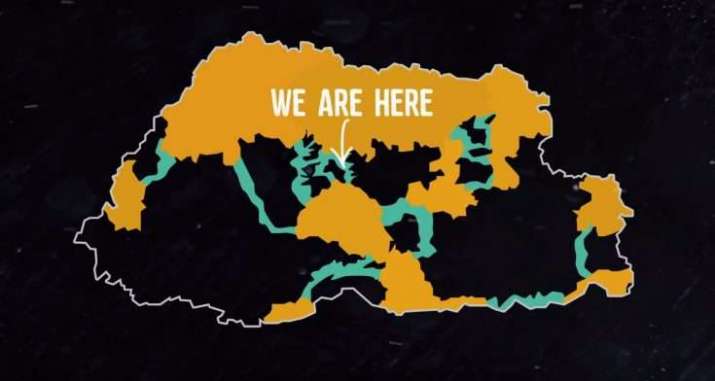 A map of Bhutan, with national parks highlighted in orange and wildlife corridors indicated in green. The arrow points to Corridor 8. From blog.wwf.org.uk
A map of Bhutan, with national parks highlighted in orange and wildlife corridors indicated in green. The arrow points to Corridor 8. From blog.wwf.org.uk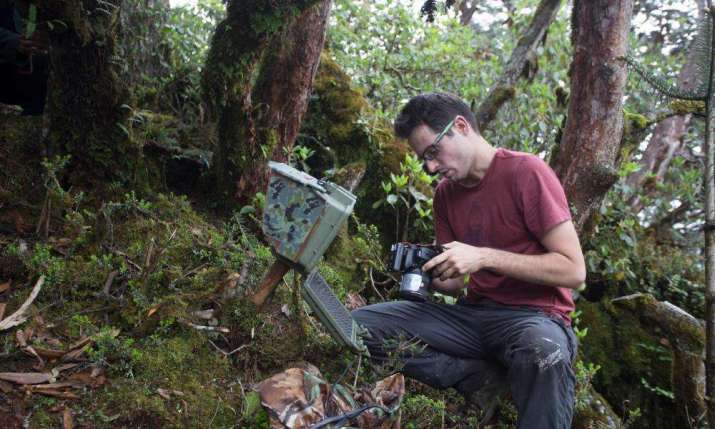 Emmanuel Rondeau. From wwf.org.uk
Emmanuel Rondeau. From wwf.org.uk“In Bhutan, there are 10 protected areas and connecting ‘corridors’ that together cover 51 per cent of the country,” Rondeau explained in a blog for the WWF. “This includes national parks and wildlife sanctuaries, home to many of the country’s amazing wildlife. It’s important these areas are connected by protected corridors so that wildlife can move around.” (WWF UK BLOG)
A small Vajrayana Buddhist nation* with a population of fewer than 800,000 people, Bhutan is no stranger to the concept of responsible environmental stewardship that accompanies its conservative approach to economic development: it is renowned as one of the Earth’s rare but essential carbon sinks.** The kingdom has also taken on a key role in tiger conservation. Home to an estimated 103 wild tigers, the country is taking strides to ensure tiger safety and to encourage natural breeding in a region where poaching and illegal wildlife trading are rife.
Despite harsh weather conditions and rugged terrain, Rondeau and a team of WWF field staff concealed eight camera traps along “Corridor 8,” a mountainous area more than 3,500 meters above sea level connecting two national parks.
“Unfortunately, wildlife corridors don’t always receive the protection they need—they aren’t monitored or patrolled as much as national parks, said Rondeau. “But making sure tigers are able to move across whole landscapes is a key part of the [WWF’s] strategy to double the number of wild tigers by 2022. For example, a well-protected corridor could help a tiger from one national park meet and mate with a tigress in another park.” (WWF UK BLOG)
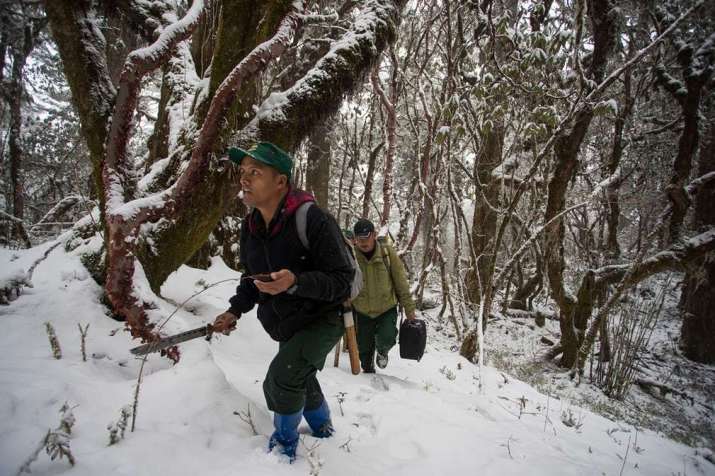 Ranger Dorji Duba patrolling Corridor 8 in northern Bhutan. Photo by Emmanuel Rondeau. From theguardian.com
Ranger Dorji Duba patrolling Corridor 8 in northern Bhutan. Photo by Emmanuel Rondeau. From theguardian.comWhile comprehensive scientific studies still need to be performed, Emmanuel’s success in capturing images and footage of wild tigers in Bhutan will enable the WWF’s local team to highlight how vital these areas for the endangered tigers and the need for increased protection and habitat management plans. Indeed, the area in which the team was working is already under developmental pressure, with plans for highway construction and a hydro-electric project, as well as clashes between wildlife and human settlements.
“For the first time in about 100 years, the global wild tiger numbers have been increasing to a total estimate of 3,890 individuals—so that’s really amazing,” Rondeau observed. “That didn’t mean my tiger mission in Bhutan was easy, though—the last tiger survey revealed that there were only around 100 tigers in the wild there, and sure enough it was 23 days before my cameras first picked up a tiger. When I saw the tiger on my camera screen for the first time, I couldn’t believe it. It was such a clear shot, and exactly what I needed to show that tigers are using these corridors and to help strengthen conservation measures.” (WWF)
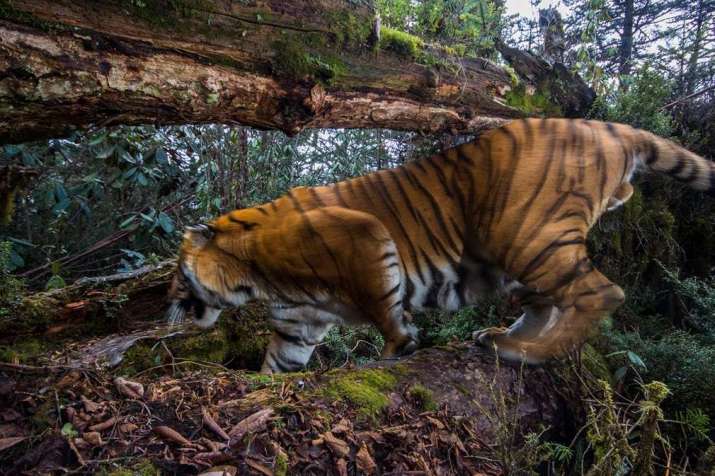 A wild Bengal tiger captured by a camera trap in Corridor 8, Trongsa, Bhutan. Photo by Emmanuel Rondeau. From theguardian.com
A wild Bengal tiger captured by a camera trap in Corridor 8, Trongsa, Bhutan. Photo by Emmanuel Rondeau. From theguardian.com* Almost 75 per cent of Bhutanese identify as Buddhists, according to data for 2010 from the Washington, DC-based Pew Research Center, with Hinduism accounting for the majority of the remainder. Most of Bhutan’s Buddhists follow either the Drukpa Kagyu or the Nyingma school of Vajrayana Buddhism.
** Bhutan’s high level of forest cover means that not only has the kingdom met its pledge to remain carbon neutral, it is actually a carbon sink, meaning its forests absorb more carbon dioxide than the country produces.
See more
CAUGHT ON CAMERA: Beautiful new camera trap images show that tigers roam far and wide in Bhutan (WWF)
Amazing image of wild tiger in Bhutan (WWF)
Rare tiger in Bhutan captured on camera (WWF UK BLOG)
Wild tigers of Bhutan – in pictures (The Guardian)
Super rare tigers photographed in the wild (BBC)
Related news from Buddhistdoor Global
New Wildlife Reserve Could Help Save China’s Big Cats
Bhutan Convenes Inaugural International Conference on Vajrayana Buddhism
Dzongsar Khyentse Rinpoche Concludes Rinchen Terdzö Empowerments in Bhutan
Bhutan Plants 108,000 Trees to Celebrate Birth of Crown Prince
Related features from Buddhistdoor Global
Special Issue 2017: Planetary Healing: Buddhism and World Ecology
An Agent of Change: Empowering Bhutanese Nuns
Preserving Bhutan’s Cultural Heritage: An Interview with Princess Ashi Kesang Choden T. Wangchuck














